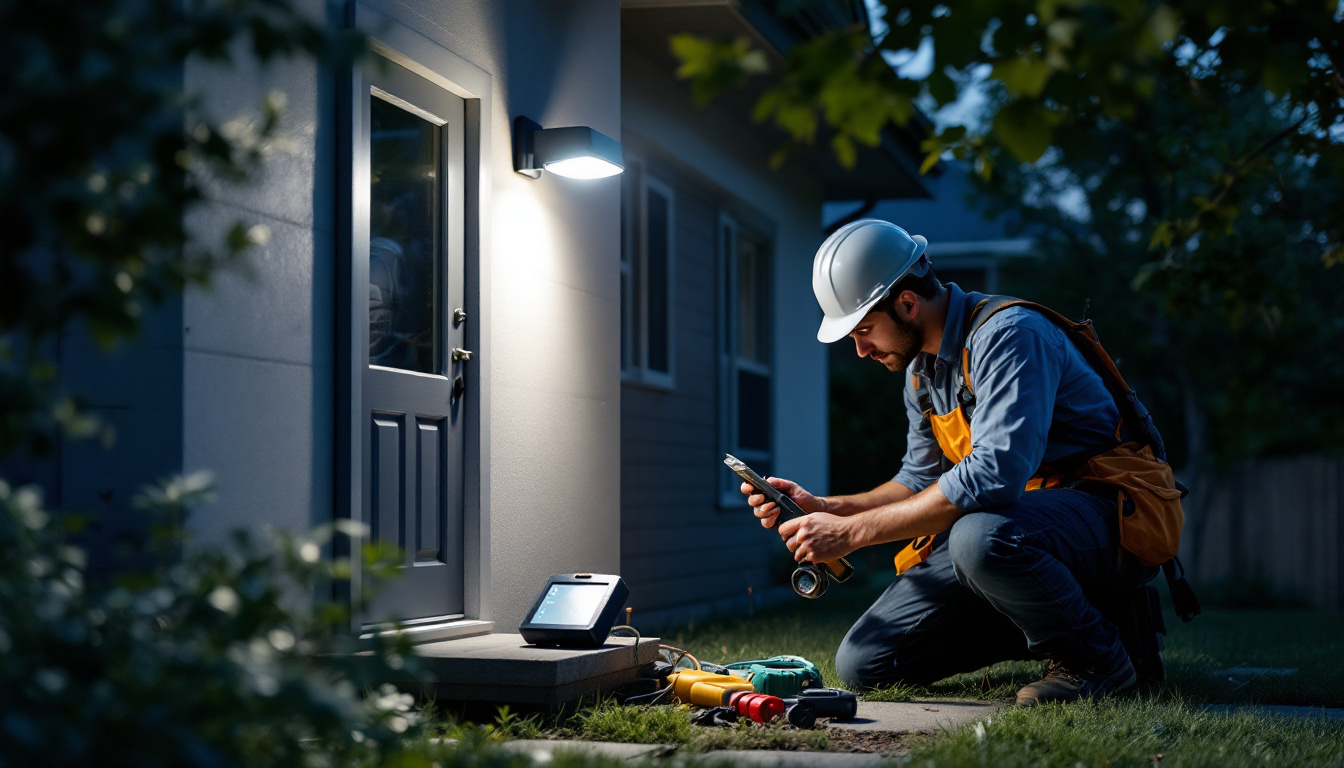
Photocell outdoor lights have become a popular choice for both residential and commercial properties. They provide convenience, safety, and energy efficiency by automatically turning on and off based on ambient light levels. However, even experienced lighting contractors can make mistakes when installing or recommending these systems. This article explores common pitfalls to avoid, ensuring that installations are successful and meet client expectations.
Before delving into the common mistakes, it is essential to have a solid understanding of how photocell technology works. Photocells, also known as photoelectric sensors, detect light levels and control the operation of outdoor lighting fixtures accordingly. They can be used in various applications, from streetlights to garden pathways, and are designed to enhance safety and security. By automating the lighting process, photocells not only improve convenience but also contribute to energy efficiency, making them a popular choice for both residential and commercial properties.
Photocells function by sensing the intensity of natural light. When daylight is present, the photocell keeps the lights off. As dusk approaches and light levels drop, the sensor triggers the lights to turn on. Conversely, when daylight returns, the photocell turns the lights off again. This automatic operation is beneficial for reducing energy consumption and prolonging the lifespan of the lighting fixtures. Moreover, many modern photocells are equipped with adjustable sensitivity settings, allowing users to customize the threshold at which the lights activate, ensuring optimal performance based on specific environmental conditions.
There are primarily two types of photocells: integrated and standalone. Integrated photocells are built into the light fixture, while standalone units are separate devices that can be connected to existing lighting systems. Each type has its advantages, and understanding these can help contractors make informed recommendations to clients. Integrated photocells tend to offer a streamlined design and ease of installation, while standalone units provide flexibility in retrofitting older lighting systems. Additionally, some advanced standalone photocells come with features like timers and dimming capabilities, allowing for even greater control over outdoor lighting and enhancing the overall user experience.
Furthermore, the advancements in photocell technology have led to the development of smart photocells that can be integrated with home automation systems. These smart sensors can communicate with other devices, such as security cameras and smart home hubs, to create a cohesive and responsive lighting environment. For instance, they can be programmed to work in conjunction with motion sensors, ensuring that lights not only turn on at dusk but also respond to movement, providing an added layer of security. This integration of technology not only improves functionality but also offers users the ability to monitor and control their outdoor lighting remotely, making it an attractive option for tech-savvy homeowners.
Even with a solid understanding of photocell technology, mistakes can occur during installation. These errors can lead to malfunctioning systems, increased energy costs, and dissatisfied clients. Here are some of the most common mistakes lighting contractors make when installing photocell outdoor lights.
One of the most critical factors in the effective operation of photocells is their placement. Installing a photocell in a location that is too shaded or exposed to artificial light can cause it to malfunction. For instance, placing a sensor near streetlights or under trees can prevent it from accurately detecting ambient light levels.
To avoid this mistake, contractors should carefully assess the installation site. The photocell should be positioned where it can receive unobstructed exposure to natural light. This ensures that it can accurately sense when to turn the lights on and off.
Lighting contractors must be aware of local regulations regarding outdoor lighting. Some areas have specific guidelines about light pollution, which can affect the placement and type of photocell lights used. Failing to comply with these regulations can lead to fines and the need for costly rework.
Before starting an installation, it is advisable to research local ordinances and guidelines. This not only helps avoid legal issues but also positions the contractor as a knowledgeable professional who respects community standards.
Selecting the appropriate type of photocell for a specific application is crucial. Contractors often make the mistake of using the same photocell for every installation, regardless of the environment or intended use. Different settings may require different types of sensors.
Environmental factors such as weather conditions, geographical location, and the presence of nearby structures can impact the performance of photocells. For example, in areas with frequent rain or snow, a weather-resistant photocell is essential. Similarly, in regions with high levels of ambient light, a more sensitive photocell may be necessary to ensure proper functioning.
Contractors should take the time to assess these environmental factors and choose photocells that are specifically designed for the conditions they will face. This attention to detail can significantly enhance the reliability and efficiency of the lighting system.
Compatibility between the photocell and the lighting fixtures is another common oversight. Not all photocells work seamlessly with every type of light fixture. For instance, LED lights may require different photocells than traditional incandescent bulbs. Using an incompatible photocell can lead to flickering lights, premature burnout, or complete system failure.
To avoid these issues, it is essential to verify that the chosen photocell is compatible with the lighting fixtures being installed. This may involve consulting product specifications or manufacturer guidelines to ensure a successful match.
Lighting contractors often overlook the importance of educating their clients about the operation and maintenance of photocell outdoor lights. Clients may have misconceptions about how these systems work, leading to frustration if they do not function as expected.
It is crucial to communicate the capabilities and limitations of photocell lights to clients. For example, some clients may expect the lights to turn on at the exact moment the sun sets. However, factors such as weather conditions and seasonal changes can affect the timing of the photocell’s response.
By setting realistic expectations, contractors can help clients understand the nuances of their lighting systems. This transparency can lead to greater satisfaction and trust in the contractor’s expertise.
In addition to setting expectations, contractors should provide clients with maintenance guidelines for their photocell outdoor lights. This includes information on how to keep the sensors clean and free from obstructions, as well as when to check for functionality. Regular maintenance can extend the lifespan of the system and ensure optimal performance.
Energy efficiency is a significant selling point for photocell outdoor lights. However, contractors sometimes overlook the importance of integrating energy-efficient practices into their installations. This can result in higher energy costs for clients and diminish the overall appeal of the lighting system.
When installing photocell lights, it is important to pair them with energy-efficient fixtures. LED lights, for example, consume significantly less energy than traditional incandescent bulbs. By recommending energy-efficient options, contractors can help clients save money on their utility bills while also reducing their environmental footprint.
Incorporating energy-efficient fixtures not only benefits the client but also enhances the contractor’s reputation as a knowledgeable and responsible professional in the lighting industry.
Another trend in outdoor lighting is the integration of smart technology. Many modern photocell systems can be connected to smart home networks, allowing for remote control and monitoring. Contractors who fail to mention these options may miss an opportunity to offer clients enhanced functionality and convenience.
By staying informed about advancements in lighting technology, contractors can provide clients with innovative solutions that meet their evolving needs. This can lead to increased customer satisfaction and potential referrals.
Photocell outdoor lights may require seasonal adjustments to ensure optimal performance throughout the year. Contractors often neglect this aspect, leading to systems that do not function correctly during certain times of the year.
One common issue arises during the transition into and out of daylight savings time. Photocells may need to be recalibrated to account for the changes in daylight hours. Failing to make these adjustments can result in lights turning on too early or too late, frustrating clients.
Contractors should remind clients about the importance of adjusting their photocell systems during these transitions. Providing a simple checklist or reminder can help clients maintain their lighting systems effectively.
Throughout the year, natural light levels can vary significantly. For example, during winter months, the sun sets earlier, and the intensity of light changes. Photocells may need to be recalibrated or adjusted to account for these seasonal variations. Ignoring this can lead to inefficient operation and increased energy costs.
Contractors should educate clients on the importance of monitoring their photocell systems and making necessary adjustments as seasons change. This proactive approach can enhance the longevity and efficiency of the lighting system.
Photocell outdoor lights offer numerous benefits, but the potential for mistakes during installation and maintenance is significant. By understanding the technology, avoiding common pitfalls, and educating clients, lighting contractors can ensure successful installations that meet client expectations. Paying attention to placement, compatibility, energy efficiency, and seasonal adjustments can make all the difference in delivering a reliable and effective lighting solution.
Ultimately, a well-executed photocell lighting installation not only enhances safety and security but also contributes to energy savings and client satisfaction. By avoiding these common mistakes, contractors can position themselves as trusted experts in the field, paving the way for future success.
Ready to avoid the common pitfalls of photocell outdoor light installation and delight your clients with top-notch, energy-efficient lighting solutions? Look no further than LumenWholesale for all your lighting needs. Our spec-grade products ensure you have access to the highest quality lighting at wholesale prices that simply can’t be beaten. With our commitment to quality, affordability, and convenience, you can confidently tackle any project, knowing you’re backed by the best in the business. Don’t let hidden fees dim your success—choose LumenWholesale for hassle-free bulk buying with free shipping. Elevate your lighting installations today by visiting Wholesale Lighting at the Best Value and experience the LumenWholesale difference.

Discover the top light fixture brands that dominate venue concerts and understand why these choices are crucial for lighting contractors.

Discover the common pitfalls lighting contractors face when working with portable UV lighting.

Discover essential insights for lighting contractors on selecting and installing big ceiling fans.

Discover the essential guide for lighting contractors with our comprehensive checklist on motion detector switches.